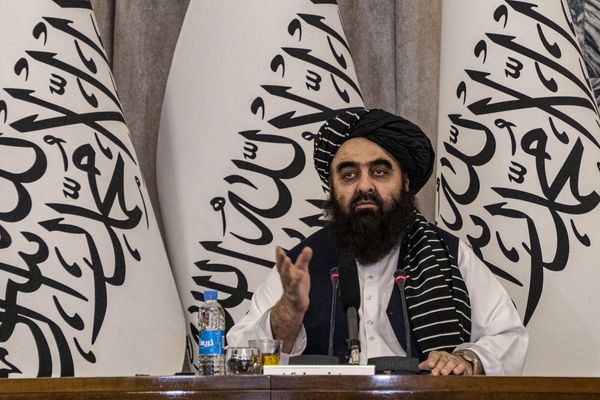
Ukraine began 2024 on the defensive and Kyiv’s battlefield prospects are dimming further as Republicans in the US Congress appear increasingly to be intent on blocking future military aid. If Europe does not plug the gap, Ukraine risks slow-motion defeat from 2025.
A simple figure sums up the problem. Ukraine is once again being outgunned in this near two-year-old war: the current estimate is that Russia is firing 10,000 artillery shells a day to Ukraine’s 2,000, a dismal ratio that may yet worsen in the absence of future US gifts of ammunition.
A recent report on the UK’s Sky News highlighted a group of Ukrainian gunners with the 22nd brigade, operating between Chasiv Yar and Russian-held Bakhmut, and featured their pleas for help and limited stockpiles of shells. Their Soviet-standard 152mm gun was fired only three times in a night to protect the supplies available.
“What that means is that Ukrainians can’t suppress Russian artillery any more, and if the Ukrainians can’t fire back, all they can do is try to survive,” said Sam Cranny-Evans, of the Royal United Services Institute thinktank.
Russia, meanwhile, has managed a transition to a war economy. Analysis by Estonia has concluded that Moscow’s factories will produce about 4.5m shells in 2024 (more than 12,000 a day), with Russia having lifted defence spending to a high but sustainable level of 6.5% of GDP. Smaller Ukraine is reliant on western industrial support, but the US political divisions mean the Pentagon has had no more money to spend since the beginning of January, while European efforts have faltered.
Europe had committed to produce 1m shells for Ukraine in the year to the end of March but has fallen short and will instead produce anywhere between 480,000 to 700,000, Estonia estimates.
“In Europe, the problem has been to put together sufficiently large orders to make it worthwhile for privately owned companies to invest in expanding their capacity,” said Nick Witney, a former chief executive of the European Defence Agency. As a result, Ukraine is reliant on its own manufacturing and any remaining gifts.
Ironically, the US, which produces its shells in government-owned plants, has found ways to lift up its own production, from 28,000 last October to a projected 37,000 in April, 60,000 in October 2024 and 100,000 in October 2025, according to a US thinktank. Even that is well short of helping Ukraine match Russia on the frontline, but without the US, Europe will have to double its own already underpowered efforts in 2024.
The war is about more than artillery, of course, and Ukraine is developing alternative strategies, focusing on developing at least 1m small and cheap “first-person view” armed drones during 2024. Controlled as if in a video game, the highly manoeuvrable drones are effective in combat but their smaller payload makes them a limited substitute for artillery – while the Russians have proved able to imitate Ukrainian efforts with their own drones.
Ukraine has recognised since the beginning of December that it needs to switch to the defensive, and the president has ordered a strengthening of fortifications. As the Russians showed successfully during 2023, mining deep behind the frontlines should prevent an immediate breakthrough.
In any event, the Kremlin’s generals have still not shown they are able to attack effectively. An assault on the frontline town of Avdivvka, in the eastern Donbas, began in October and has continued, with Russian forces making incremental gains at high costs. Western intelligence estimated last week that Russia had lost 365 main battle tanks in the four months of fighting, just about ahead of Moscow’s estimated replenishment rate of about 125 tanks a month.
Ukraine nevertheless badly needs more troops to reinforce its exhausted and depleted frontline forces, with parliament debating controversial new mobilisation laws after a call from the ousted chief of staff, Valerii Zaluzhyni, for 450,000 to 500,000 fresh soldiers. It is not clear how many will ultimately be pressed into service.
Russia, meanwhile, may not mobilise further ahead of the presidential election in March, but its larger population and use of more ruthless methods always gives it an edge in numbers, able to train 130,000 every six months, according to Estonian estimates, if this is not disrupted by the need to send untrained troops into Ukraine because of the number of casualties being inflicted.
There are some technologies that in effect only the US can supply in volume at present, such as Patriot interceptors, critical in the air defence of Kyiv particularly against potent Russian Iskander and Kinzhal missiles. Russia makes and fires about 100 long-range missiles a month, Ukraine estimates, and the rule of thumb is that two interceptors are needed to halt them.
A Nato contract on behalf of Germany, the Netherlands, Romania and Spain at the beginning of January will allow for 1,000 Patriot missiles to be made in Germany at some point, some of which could eventually reach Ukraine – although Kyiv would doubtless have preferred if such an arrangement had been reached a year earlier.
The expectation is that the Ukraine war will run into 2025, not least as the Kremlin waits to see if Donald Trump – widely perceived to be more sympathetic to Vladimir Putin than to Ukraine – is elected. For Ukraine to prevail, it will most likely have to endure 2024, regroup as far as possible, and hope European politicians concentrate on basic rearmament.
“I think the war will be with us for at least another year,” said Cranny-Evans, “and the situation need not be catastrophic if European allies fill the void left by the US. Europe’s economy is still far larger than Russia’s.”







